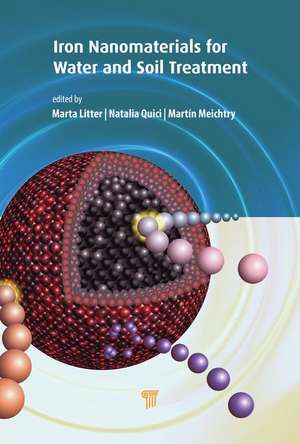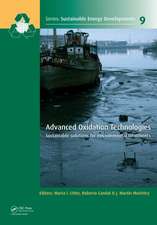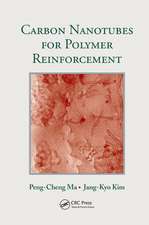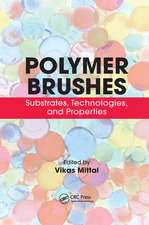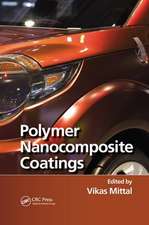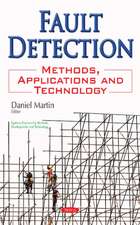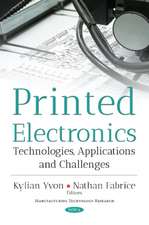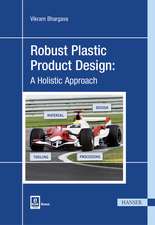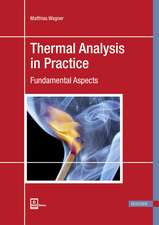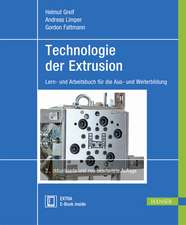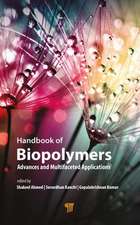Iron Nanomaterials for Water and Soil Treatment
Editat de Marta I. Litter, Natalia Quici, Martin Meichtryen Limba Engleză Hardback – 11 mai 2018
This book focuses on the methods of preparation of iron nanomaterials that can carry out contaminant removal processes and the use of these nanoparticles for cleaning waters and soils. It carefully explains the different aspects of the synthesis and characterization of iron nanoparticles and methods to evaluate their ability to remove contaminants, along with practical deployment. It overviews the advantages and disadvantages of using iron-based nanomaterials and presents a vision for the future of this nanotechnology. While this is an easy-to-understand book for beginners, it provides the latest updates to experts of this field. It also opens a multidisciplinary scope for engineers, scientists, and undergraduate and postgraduate students.
Although there are a number of books published on the subject of nanomaterials, not too many of them are especially devoted to iron materials, which are rather of low cost, are nontoxic, and can be prepared easily and envisaged to be used in a large variety of applications. The literature has scarce reviews on preparation of iron nanoparticles from natural sources and lacks emphasis on the different processes, such as adsorption, redox pathways, and ionic exchange, taking place in the removal of different pollutants. Reports and mechanisms on soil treatment are not commonly found in the literature. This book opens a multidisciplinary scope for engineers and scientists and also for undergraduate or postgraduate students.
Preț: 848.35 lei
Preț vechi: 1034.58 lei
-18% Nou
Puncte Express: 1273
Preț estimativ în valută:
162.35€ • 168.87$ • 134.03£
162.35€ • 168.87$ • 134.03£
Carte tipărită la comandă
Livrare economică 14-28 aprilie
Preluare comenzi: 021 569.72.76
Specificații
ISBN-13: 9789814774673
ISBN-10: 9814774677
Pagini: 338
Ilustrații: 11 Tables, black and white; 19 Illustrations, color; 36 Illustrations, black and white
Dimensiuni: 152 x 229 x 21 mm
Greutate: 0.79 kg
Ediția:1
Editura: Jenny Stanford Publishing
Colecția Jenny Stanford Publishing
ISBN-10: 9814774677
Pagini: 338
Ilustrații: 11 Tables, black and white; 19 Illustrations, color; 36 Illustrations, black and white
Dimensiuni: 152 x 229 x 21 mm
Greutate: 0.79 kg
Ediția:1
Editura: Jenny Stanford Publishing
Colecția Jenny Stanford Publishing
Public țintă
Academic, Postgraduate, and Professional Practice & DevelopmentCuprins
1. The Story and Future of Nanoparticulated Iron Materials
2. Zerovalent Iron Nanoparticle Composites for Water Treatment: An Overview
3. Adsorption of Groundwater Pollutants by Iron Nanomaterials
4. Application of Nanozerovalent Iron for Water Treatment and Soil Remediation: Emerging Nanohybrid Approach and Environmental Implications
5. An Integrated Experimental and Modeling Approach to Assess the Mobility of Iron-Based Nanoparticles in Groundwater Systems
6. Nanoscale Zerovalent Iron Particles for Groundwater and Soil Treatment: Monitoring and Control of Their Solid-State Synthesis, Stability, and Activity
7. Nanoiron for Site Remediation: Bench-Scale Assessment and Field Applications
8. Use of Nanoparticulated Iron Materials for Chromium, Arsenic, and Uranium Removal from Water
9. Iron Nanoparticles for Cr(VI) Removal from Contaminated Soil
10. Nitrate Removal by Bimetallic Catalysts Supported by Iron Nanomaterials
11. Iron or Iron-Based Bimetallic Nanoparticle-Immobilized Electrospun Polymer Nanofibers for Environmental Remediation Applications
12. Environmental Effects of the Application of Iron Nanoparticles for Site Remediation
13. Future and Perspectives of the Use of Iron Nanoparticles for Water and Soil Remediation
2. Zerovalent Iron Nanoparticle Composites for Water Treatment: An Overview
3. Adsorption of Groundwater Pollutants by Iron Nanomaterials
4. Application of Nanozerovalent Iron for Water Treatment and Soil Remediation: Emerging Nanohybrid Approach and Environmental Implications
5. An Integrated Experimental and Modeling Approach to Assess the Mobility of Iron-Based Nanoparticles in Groundwater Systems
6. Nanoscale Zerovalent Iron Particles for Groundwater and Soil Treatment: Monitoring and Control of Their Solid-State Synthesis, Stability, and Activity
7. Nanoiron for Site Remediation: Bench-Scale Assessment and Field Applications
8. Use of Nanoparticulated Iron Materials for Chromium, Arsenic, and Uranium Removal from Water
9. Iron Nanoparticles for Cr(VI) Removal from Contaminated Soil
10. Nitrate Removal by Bimetallic Catalysts Supported by Iron Nanomaterials
11. Iron or Iron-Based Bimetallic Nanoparticle-Immobilized Electrospun Polymer Nanofibers for Environmental Remediation Applications
12. Environmental Effects of the Application of Iron Nanoparticles for Site Remediation
13. Future and Perspectives of the Use of Iron Nanoparticles for Water and Soil Remediation
Notă biografică
Marta I. Litter is a researcher at the National Atomic Energy Commission (CNEA), a superior researcher at the National Scientific and Technical Research Council (CONICET), and a full professor of the National University of General San Martín, Argentina. She is a PhD in chemistry from the University of Buenos Aires, Argentina, and a postdoctorate from the University of Arizona, USA. She has authored more than 200 scientific publications in international journals, books, and chapters of books. She is recipient of the MERCOSUR Science and Technology Award in 2006 and 2011. She was president of the local organizing committee of the 5th International Congress on Arsenic in the Environment (As2014), Buenos Aires, Argentina. She was recently designated as pioneer on photocatalysis in Argentina (2016). Her research focuses on treatment of organic and inorganic contaminants in water and air by innovative advanced technologies, especially heterogeneous photocatalysis, and use of nanomaterials.
Natalia Quici is a researcher at CNEA, an adjunct researcher at CONICET, and head of the Chair of Physical Chemistry at Buenos Aires School of the National Technological University (UTN.BA), Argentina. She received her degree as a chemical engineer from UTN.BA and her doctoral degree from the Engineering Faculty of the University of Buenos Aires. She was a postdoctoral fellow at the University of Nottingham, UK, during 2009–2010 and at Loughborough University, UK, during 2010–2012. Her current research focuses on the use of nanomaterials for environmental remediation and chemistry.
Martín Meichtry is a researcher at the Environmental Remediation Chemistry Division, Chemistry Management, CNEA; a joint researcher at CONICET; and assistant professor at the Chemistry Department, UTN.BA. His current research focuses on the development and application of advanced processes, such as heterogeneous photocatalysis, and nanoparticulated iron-based technologies and ultrasound for the treatment of air, water, and soil pollutants and conversion of energy. He has authored 22 articles in international peer-reviewed journals, 8 book chapters, 4 books, and several technical reports.
Natalia Quici is a researcher at CNEA, an adjunct researcher at CONICET, and head of the Chair of Physical Chemistry at Buenos Aires School of the National Technological University (UTN.BA), Argentina. She received her degree as a chemical engineer from UTN.BA and her doctoral degree from the Engineering Faculty of the University of Buenos Aires. She was a postdoctoral fellow at the University of Nottingham, UK, during 2009–2010 and at Loughborough University, UK, during 2010–2012. Her current research focuses on the use of nanomaterials for environmental remediation and chemistry.
Martín Meichtry is a researcher at the Environmental Remediation Chemistry Division, Chemistry Management, CNEA; a joint researcher at CONICET; and assistant professor at the Chemistry Department, UTN.BA. His current research focuses on the development and application of advanced processes, such as heterogeneous photocatalysis, and nanoparticulated iron-based technologies and ultrasound for the treatment of air, water, and soil pollutants and conversion of energy. He has authored 22 articles in international peer-reviewed journals, 8 book chapters, 4 books, and several technical reports.
Descriere
This book focuses on the preparation of iron nanomaterials that can carry out removal processes and the use of these nanoparticles for cleaning waters and soils. It carefully explains the different aspects of the synthesis and characterization of iron nanoparticles and methods to evaluate their ability to remove contaminants, along with practical deployment. It overviews the advantages and disadvantages of using iron-based nanomaterials and presents a vision for the future of this nanotechnology.
